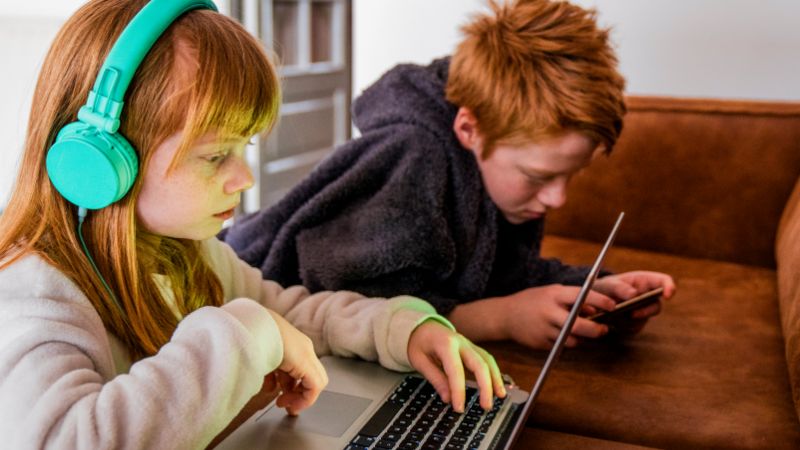Is your child spending more time online these days? Whether they’re doing homework, playing games, or chatting with friends, the digital world is now a huge part of their daily life. And if you’re like most parents, you probably have a lot of questions about keeping them safe online.

This comprehensive guide breaks down online safety into simple, actionable steps that any parent can follow.
Here’s what you’ll learn:
- How to set up effective safety measures without being the “strict parent”
- Smart ways to talk to your kids about online risks
- Essential parental controls that actually work
- Practical tips for monitoring screen time
- Strategies that grow with your child from elementary to teen years
Ready to create a safer online experience for your family? Check it out in this article.
Understanding Online Risks: What Parents Need to Know
Before we talk about solutions, let’s quickly look at what we’re protecting our kids from:
Key Online Risks:
- Cyberbullying (affecting up to 60% of youth)
- Exposure to inappropriate content
- Online predators
- Privacy breaches
- Digital scams
5 ways to keep your kids safe online
Start With Open Conversations
The foundation of online safety isn’t about strict rules – it’s about communication.
Parents should establish regular conversations about internet safety from an early age. Encourage children to talk about what they see and do online without fear of judgment or punishment. When adults remain approachable, kids are more likely to report concerning interactions.
Here’s how to get started:
- Make it casual:Use daily moments (like watching videos together) to chat about online safety
- Stay judgment-free:Kids need to know they can come to you with concerns
- Ask open questions:“What’s the coolest thing you discovered online today?”
- Share your own experiences:Kids learn best when we’re honest about our own digital challenges
Set Clear Ground Rules
Parents should create specific guidelines about screen time, appropriate websites, and online behavior that their kids can easily understand.

Basic ground rules might include:
- Screen-free zones (like dinner table and bedrooms)
- No sharing personal information online
- No talking to strangerswithout permission
- No downloading files without asking first
- Time limits for device usage
These rules should be age-appropriate and evolve as children grow older. For younger children, simple rules with direct supervision work best, while teenagers may need more nuanced guidelines that respect their growing independence.
Consider creating a family media agreement that everyone signs. This document can outline when and where devices are allowed, what apps or sites are permitted, and consequences for breaking the rules.
It’s also helpful to explain the “why” behind each rule. Children are more likely to follow guidelines when they understand they exist for protection rather than restriction.
Monitoring and Time Management
Parents can use various monitoring tools that track screen time and app usage while respecting children’s growing need for privacy.
Recommended monitoring approaches:
- Age-appropriate tracking apps that provide activity reports
- Regular check-ins rather than constant surveillance
- Open conversations about what’s being monitored and why
Establishing consistent time limits helps prevent excessive screen use. Many families find success with tech-free zones like dinner tables and bedrooms, creating natural breaks from digital engagement.
Time management tools can be particularly helpful for families. Most devices now include built-in screen time management features that parents can configure together with their children.
Simple time management strategies:
- Set clear before/after school screen rules
- Use timers for younger children
- Encourage breaks every 30-45 minutes
- Create tech-free times during family activities
As children demonstrate responsible online behavior, parents can gradually reduce monitoring. This step-by-step approach helps kids develop self-regulation skills they’ll need throughout life.
Spend Time with Them Online
One of the most effective ways to keep children safe online is to spend time with them as they navigate digital spaces. This shared experience creates natural opportunities for discussions about online safety without feeling like a lecture.

Benefits of shared online time:
- Builds trust and open communication
- Teaches critical thinking about online content
- Allows parents to spot potential problems early
- Creates opportunities for casual safety conversations
When parents show genuine interest in children’s online activities, kids are more likely to approach them when encountering something troubling. This ongoing dialogue helps children develop better judgment about online interactions.
Consider creating family accounts on gaming platforms or watching online videos together. These shared experiences make it easier to demonstrate appropriate online behavior and responses to concerning content.
Model Healthy Online Habits
Children learn by watching their parents. When adults demonstrate responsible digital citizenship, kids naturally follow suit.
Be mindful of your screen time. If you’re constantly glued to your phone, children will assume this is normal behavior. Try setting designated device-free times during meals or family activities.
Show children how to think critically about online content. Talk aloud when evaluating whether a news story seems trustworthy or when deciding not to share unverified information.
Practice respectful communication in your online interactions. Children notice how you respond to disagreements on social media or how you talk about others in digital spaces.
Demonstrate proper privacy protection by:
- Using strong passwords
- Being selective about what personal information you share
- Asking permission before posting photos of others
- Regularly reviewing privacy settings together
Remember that children are more likely to follow what you do rather than what you say. Your consistent modeling of healthy digital habits will have a lasting impact on their online behavior.

Putting It All Together: Your Next Steps for Online Safety
As we’ve explored, keeping kids safe online doesn’t have to be overwhelming. The key ingredients are open communication, clear guidelines, active involvement, and consistent monitoring – all wrapped in a supportive, understanding approach.
But how do we put these principles into practice, especially when it comes to digital communication?
This is where apps like JusTalk Kids can make a real difference in your family’s digital safety journey.
Why Consider JusTalk Kids?
JusTalk Kids aligns perfectly with the safety principles we’ve discussed:
- Stranger-Free Environment: The app ensures children can only receive calls and messages from parent-approved contacts, eliminating risks from unknown users
- End-to-End Encryption: All personal information and conversations are fully encrypted, protecting your child’s privacy
- Parent-Controlled: Parents manage connections through the JusTalk/JusTalk Familyapp, maintaining oversight while giving kids their own safe space
- Kid-Friendly Features: Children can express themselves creatively with age-appropriate doodles, stickers, and games during calls, making safe communication fun and engaging
- Wi-Fi Based: Kids can video call and message without the risks associated with traditional phone numbers or social media accounts
Ready to Take Action?
If you’re looking to implement the safety strategies we’ve discussed while giving your children a fun, secure way to connect with family and friends, consider downloading JusTalk Kids. Parents can get started with JusTalk /JusTalk Family while children use JusTalk Kids – creating a protected communication channel that grows with your family.
Download JusTalk Kids today and take the first step toward safer, more enjoyable online communication for your family.

